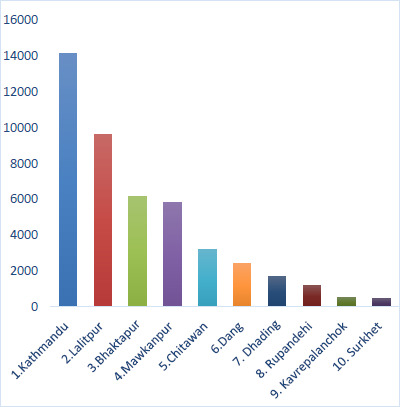尼泊尔的登革热困境。
IF 5.8
Q3 PUBLIC, ENVIRONMENTAL & OCCUPATIONAL HEALTH
引用次数: 1
摘要
本文章由计算机程序翻译,如有差异,请以英文原文为准。

Dengue Dilemma in Nepal.
The first case of Dengue in Nepal was reported in 2004, after a traveller returned from India. Dengue has since then been an endemic disease within the country with all 4 serotypes (DENV-1,DENV-2,DENV-3 and DENV-4) being known to exist and circulate within the region. Based on epidemiological records the DENV-1 and DENV-2 serotypes have traditionally been the most incriminated serovars in terms of national disease burden according to the Epidemiology and the disease control division (EDCD). Since the beginning of January 2022 up until the 28th of September 2022 over 28000 cases of confirmed and suspected cases of dengue fever have been reported to the WHO with a total of 38 deaths being documented across all of Nepal’s provinces. To date the predominant implicated serotype or serotypes have not been identified. The province most adversely affected is the Bagmati province which accounts for 78.2% of the cases and 68.4% of the fatalities noted in Nepal. A further rise in cases has been noted as of the 8th of August 2022. This dengue outbreak is the largest recorded outbreak within the small mountainous regions recent history.
The latest data released by the Ministry of health and population of Nepal (11th December 2022), has recorded a total of 54232 cases with the Bagmati province accounting for 42143 thereof and Lumbini province 4984 respectively. To date a total of 67 deaths have been confirmed. The top 10 reporting districts are namely: 1.Kathmandu (14165) 2.Lalitpur (9614) 3.Bhaktapur(6145) 4.Mawkanpur (5830) 5.Chitawan (3188) 6.Dang (2405) 7. Dhading(1678) 8. Rupandehi (1203) 9. Kavrepalanchok (536) and 10. Surkhet (470) cases respectively.
Due to the treatment of the disease being predominantly supportive, the prevention of the spread through enhanced and improved vector control and elimination is recommended. The use of eradication programs, impregnated mosquito nets, larvicidal and chromosomal manipulation therapies are the most effective methods to aid and abet the control of this deadly virus. The coming months and response of the spread of the virus to the intimated control programs implemented in Nepal will act as a yardstick for the future development and course of the outbreak of Dengue within the mountainous region.
求助全文
通过发布文献求助,成功后即可免费获取论文全文。
去求助
来源期刊

Nepal Journal of Epidemiology
PUBLIC, ENVIRONMENTAL & OCCUPATIONAL HEALTH-
自引率
10.30%
发文量
13
期刊介绍:
The Nepal Journal of Epidemiology is a international journal that encompasses all aspects of epidemiology. The journal encourages communication among those engaged in the research, teaching, and application of epidemiology of both communicable and non-communicable disease, including research into health services and medical care. Also covered are new methods, epidemiological and statistical, for the analysis of data used by those who practise social and preventive medicine. It provides the most up-to-date, original, well designed, well interpreted and significant information source in the multidisciplinary field of epidemiology. We publish manuscripts based on the following sections: 1.Short communications 2.Current research trends 3.Original research 4.Case reports 5.Review articles 6.Letter to editor
 求助内容:
求助内容: 应助结果提醒方式:
应助结果提醒方式:


